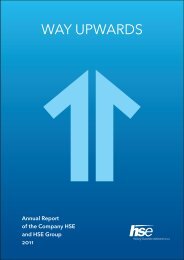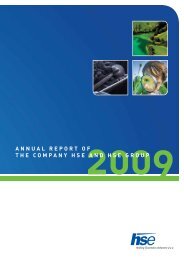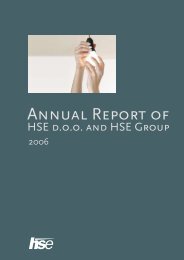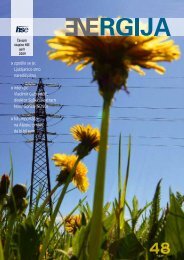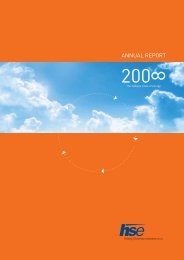Annual report - HSE
Annual report - HSE
Annual report - HSE
Create successful ePaper yourself
Turn your PDF publications into a flip-book with our unique Google optimized e-Paper software.
4.5.7.3 Long-term investments in subsidiaries<br />
Investments in subsidiaries are those where the company has the controlling influence and<br />
it performs consolidated financial statements for this group of companies.<br />
In financial statements, investments in subsidiaries are valued at cost.<br />
The company recognises revenue from investment in the period when the decision on<br />
payment of profit shares was adopted.<br />
Additional inputs in subsidiaries increase the cost of investments.<br />
Any indications of impairment of investments in subsidiaries are determined on an annual<br />
basis.<br />
In the event impartial evidence exists that a loss due to impairment was incurred, the<br />
amount of loss is measured as the difference between the carrying amount of a financial<br />
asset and the present value of estimated future cash flows discounted at the market<br />
interest rate for similar financial assets, and recognised as revaluation financial expense.<br />
If a subsidiary is submitted to liquidation, the difference between carrying amount and<br />
liquidation value of the investment is recorded in financial revenue or expenses.<br />
4.5.7.4 Financial instruments<br />
Financial instruments include the following assumptions:<br />
• non-derivative financial assets;<br />
• non-derivative financial liabilities;<br />
• derivatives.<br />
4.5.7.4.1 Non-derivative financial assets<br />
Non-derivative financial assets comprise cash and cash equivalents, receivables and loans<br />
and investment.<br />
Financial asset is derecognised when contractual rights to cash flows from this asset are<br />
discontinued or when the rights to contractual cash flows from the financial asset are<br />
transferred on the basis of a transaction in which all risks and benefits from the ownership<br />
of financial asset are transferred.<br />
Loans and receivables<br />
Loans and receivables are non-derivative financial assets with fixed or determinable<br />
payments that are not quoted in an active market.<br />
At initial recognition, loans and receivables are disclosed at fair value increased by<br />
direct costs of transaction. After initial recognition, loans and receivables are measured<br />
at amortised cost and decreased by the loss due to impairment. Loans and receivables<br />
are recorded in the statement of financial position as financial and operating assets and<br />
include granted loans with interests, receivables due from buyers and receivables due<br />
from others.<br />
In the books of account loans are recognised in accordance with settlement (repayment)<br />
date, while receivables are recognised in accordance with trading date.<br />
They are included under current assets, except in case of maturities of more than 12<br />
months after the date of the statement of financial position. In such case they are classified<br />
under long-term assets.<br />
Cash and cash equivalents<br />
Cash and cash equivalents comprise cash, bank deposits of up to three months and other<br />
short-term quickly realisable investments with original maturity of three months or less.<br />
They are carried at cost. Overdrafts on bank accounts are included under short-term<br />
financial liabilities.<br />
<strong>Annual</strong> Report <strong>HSE</strong> 2012<br />
4 Financial Report of the company <strong>HSE</strong><br />
121





